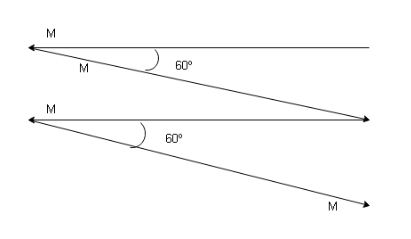
Answer
428.1k+ views
Hint : The magnetic moment vectors add up directly when they are in the same direction. Calculate the next magnetic moment due to vectors that are in the same direction and then add them to find the net magnetic moment of the vectors that are oriented at an angle to each other
Formula used:
$ |\vec R| = \sqrt {{P^2} + {Q^2} + 2PQ\cos \theta } $ where $\vec R$ is the resultant t vector formed by the addition of vectors P and Q that have an angle $\theta $ between them.
Complete step by step answer
The magnetic moments for the arrangement given in the question can be condensed into the addition of two vectors since the vectors that are in the same direction will add up directly as shown below

Now the resultant vector of the addition of vectors P and Q, since they’re not in the direction, can be calculated using the formula
$ |\vec R| = \sqrt {{P^2} + {Q^2} + 2PQ\cos \theta } $
Placing the value of $P = 2M$ and $Q = 2M$ the angle between them as $120^\circ $ we can calculate the magnitude of the resultant vector as
$ |\vec R| = \sqrt {4{M^2} + 4{M^2} + 2(4{M^2})\cos 120^\circ } $
$ |\vec R| = \sqrt {8{M^2} + 8{M^2}\left( { - \dfrac{1}{2}} \right)} $
On simplifying, we can get
$ |\vec R| = \sqrt {4{M^2}} $
$ |\vec R| = 2M$
So, the net resultant magnetic moment of the configuration given in the question will be 2M which corresponds to option (B)
Note
Since the vectors in the same direction add up directly, we don’t have to add up all 4 vectors individually and we only have to use the vector addition formula to the resultant two vectors. The magnitude of the resultant vectors must be calculated taking into account the angle between the two vectors, i.e. the angle formed between the tails of the two vectors which is $120^\circ $ and not $60^\circ $.
Formula used:
$ |\vec R| = \sqrt {{P^2} + {Q^2} + 2PQ\cos \theta } $ where $\vec R$ is the resultant t vector formed by the addition of vectors P and Q that have an angle $\theta $ between them.
Complete step by step answer
The magnetic moments for the arrangement given in the question can be condensed into the addition of two vectors since the vectors that are in the same direction will add up directly as shown below

Now the resultant vector of the addition of vectors P and Q, since they’re not in the direction, can be calculated using the formula
$ |\vec R| = \sqrt {{P^2} + {Q^2} + 2PQ\cos \theta } $
Placing the value of $P = 2M$ and $Q = 2M$ the angle between them as $120^\circ $ we can calculate the magnitude of the resultant vector as
$ |\vec R| = \sqrt {4{M^2} + 4{M^2} + 2(4{M^2})\cos 120^\circ } $
$ |\vec R| = \sqrt {8{M^2} + 8{M^2}\left( { - \dfrac{1}{2}} \right)} $
On simplifying, we can get
$ |\vec R| = \sqrt {4{M^2}} $
$ |\vec R| = 2M$
So, the net resultant magnetic moment of the configuration given in the question will be 2M which corresponds to option (B)
Note
Since the vectors in the same direction add up directly, we don’t have to add up all 4 vectors individually and we only have to use the vector addition formula to the resultant two vectors. The magnitude of the resultant vectors must be calculated taking into account the angle between the two vectors, i.e. the angle formed between the tails of the two vectors which is $120^\circ $ and not $60^\circ $.
Recently Updated Pages
what is the correct chronological order of the following class 10 social science CBSE

Which of the following was not the actual cause for class 10 social science CBSE

Which of the following statements is not correct A class 10 social science CBSE

Which of the following leaders was not present in the class 10 social science CBSE

Garampani Sanctuary is located at A Diphu Assam B Gangtok class 10 social science CBSE

Which one of the following places is not covered by class 10 social science CBSE

Trending doubts
Derive an expression for drift velocity of free electrons class 12 physics CBSE

Which are the Top 10 Largest Countries of the World?

Write down 5 differences between Ntype and Ptype s class 11 physics CBSE

The energy of a charged conductor is given by the expression class 12 physics CBSE

Fill the blanks with the suitable prepositions 1 The class 9 english CBSE

Derive an expression for electric field intensity due class 12 physics CBSE

How do you graph the function fx 4x class 9 maths CBSE

The Equation xxx + 2 is Satisfied when x is Equal to Class 10 Maths

Derive an expression for electric potential at point class 12 physics CBSE




